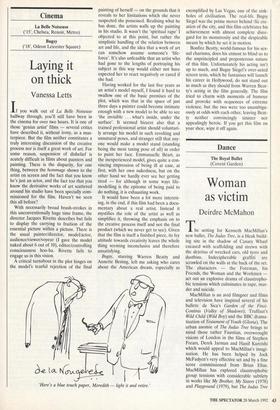Cinema
La Belle Noiseuse ('15', Chelsea, Renoir, Metro) Bugsy ('18', Odeon Leicester Square)
Laying it on thick
Vanessa Letts
If you walk out of La Belle Noiseuse halfway through, you'll still have been in the cinema for over two hours. It is one of those 'genius artist' films — several critics have described it, without irony, as a mas- terpiece. But the film neither constitutes a truly interesting discussion of the creative process nor is itself a great work of art. For some reason, suspension of disbelief is acutely difficult in films about painters and painting. There is the disparity, for one thing, between the hommage shown to the artist on screen and the fact that you know he's just an actor, and the fact too that you know the derivative works of art scattered around his studio have been specially com- missioned for the film. Haven't we seen this all before?
With necessarily broad brush-strokes in this unconventionally huge time frame, the director Jacques Rivette describes but fails to display the carrying to fruition of the essential picture within a picture. There is the usual painter/director, model/actor, audience/viewer/voyeur (I gave the model naked about 6 out of 10), editor/controlling consciousness hoo-ha. Rivette fails to engage us in this vision.
A critical turnabout in the plot hinges on the model's tearful rejection of the final painting of herself — on the grounds that it reveals to her limitations which she never suspected she possessed. Realising what he has done, the artists walls up the painting in his studio. It wasn't the 'spiritual rape' I objected to at this point, but rather the simplistic handling of the relation between art and life, and the idea that a work of art can somehow assume someone's 'life- force'. It's also unfeasible that an artist who had gone to the lengths of portraying his subject in this way would either not have expected her to react negatively or cared if she had.
Having worked for the last five years as an artist's model myself, I found it hard to swallow one of the basic premises of the plot, which was that in the space of just three days a painter could become intimate enough with a new model to be able to see 'the invisible . . . what's inside, under the surface'. It seemed bizarre also that a trained professional artist should voluntari- ly arrange his model in such revolting and unnatural poses, and stranger still that any- one would make a model stand (standing being the most taxing pose of all) in order to paint her face. Emmanuelle Mart, as the inexperienced model, gives quite a con- vincing impression of being ill at ease, at first, with her own nakedness, but on the other hand we hardly ever see her getting tired — for although in some ways life- modelling is the epitome of being paid to do nothing, it is exhausting work.
It would have been a lot more interest- ing, in the end, if this film had been a docu- mentary about a real artist. Instead it mystifies the role of the artist as well as simplifies it, throwing the emphasis on to the creative process itself and not the final product (which we never get to see). Given that the film is itself a finished piece, its fey attitude towards creativity leaves the whole thing seeming inconclusive and therefore unsatisfying.
Bugsy, starring Warren Beatty and Annette Bening, left me asking who cares about the American dream, especially as 'Here's a blue touch paper, Meredith — light it and retire.' exemplified by Las Vegas, one of the sink- holes of civilisation. The real-life Bugsy Siegel was the prime mover behind rWe cre- ation of the city, and this film celebtates his achievement with almost complete disre- gard for its monstrosity and the despicable means by which he set it in motion.
Bonfire Beatty, world-famous for his sex- ual charisma, does his utmost to blind us to the unprincipled and preposterous nature of this film. Unfortunately his acting isn't up to much, and Bugsy Siegel's over-acted screen tests, which he fantasises will launch his career in Hollywood, do not stand out as much as they should from Warren Beat- ty's acting in the film generally. The film tried to charm with moments of humour and provoke with sequences of extreme violence, but the two were too unambigu- ously at odds with each other, leaving Beat- ty neither convincingly sinister nor appealingly heroic. If you get this film on your shoe, wipe it off again.


























































 Previous page
Previous page